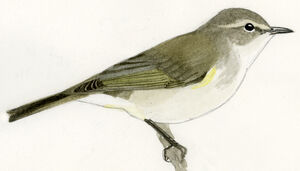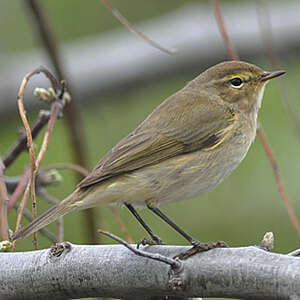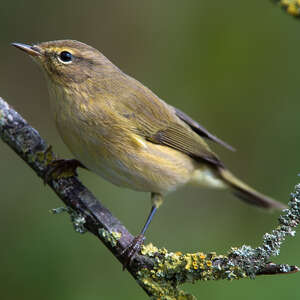Common Chiffchaff
Phylloscopus collybita - Pouillot véloce
Identification
The Common Chiffchaff, like most members of the Phylloscopus genus, is a very small bird. It measures 11-12 cm in length and weighs, on average, less than 10 g (6 to 11.5 depending on its fatness). Its dull olive-brown plumage is designed to go unnoticed in the vegetation it rarely leaves. It would go unnoticed a lot more if it weren't for its frequent chirp of an eigh? that allows it to be easily spotted. Both sexes are similar. In the subspecies typical of Western Europe, the upper parts (body and coverts) are a dull olive brown. The wings and tail are dark brown with all the feathers (flight and tail feathers) finely edged in greenish yellow, which enhances the color a bit. The underpart feathers are light beige with grayish and yellowish flecks that are sometimes visible depending on the lighting. The yellow hue is often noticeable in the wrist of the wing. The vent feathers are white. The head appears large in comparison to the body. The cap is the color of the mantle, but darker and a bit more brown. It is bordered by a discreet and undefined eyebrow (much less distinct than that of the Willow Warbler), light beige sometimes tinted with yellow. The dark eye is surrounded by a distinct white ring that stands out against the eyebrow. This eye ring is broken in front by a small dark loral line going from the eye to the bill and in back by a small dark post-ocular spot. The auricular coverts (cheeks) are beige and contrast with the lighter throat. The bill is very fine, dark brown to black, sometimes yellow at the commissure. The legs are dark brown to black with dark nails. Adults go through a complete summer molt which can be very confusing for the novice.The juvenile is characterized by its new plumage, warmer than that of the adult. The lower parts are distinctly chamois and washed with discreet yellowish hue, with a slight rufous colouring at the throat and chest. Its rectrices are pointed at the tip. 6 subspecies have been described which differ by their plumage and their voice. There is a clinal variation from west to east which leads in Russia to birds with a colder plumage, more grey-brown, less olive, a more marked eyebrow, and paler undersides (the subspecies tristis, called the Siberian Common Chiffchaff). Its call and song are also significantly different.
Subspecific information 6 subspecies
- Phylloscopus collybita collybita (w, c and se Europe)
- Phylloscopus collybita abietinus (Scandinavia and nw Russia to the Black Sea and n Iran)
- Phylloscopus collybita brevirostris (nw and n Turkey)
- Phylloscopus collybita caucasicus (Caucasus to n Iran)
- Phylloscopus collybita menzbieri (ne Iran and Turkmenistan)
- Phylloscopus collybita tristis (e Russia and n Kazakhstan to s Siberia and n Mongolia)
Foreign names
- Pouillot véloce,
- Mosquitero común,
- felosa-europeia,
- Zilpzalp,
- csilpcsalpfüzike,
- Tjiftjaf,
- Luì piccolo,
- gransångare,
- Gransanger,
- kolibiarik čipčavý,
- budníček menší,
- Gransanger,
- tiltaltti,
- mosquiter comú,
- Gransöngvari,
- pierwiosnek,
- čuņčiņš,
- vrbji kovaček,
- Пеночка-теньковка,
- チフチャフ,
- 叽喳柳莺,
- gransångare,
- 嘰喳柳鶯,
Voice song and call
The Common Chiffchaff's usual call is a soft, characteristic monosyllabic 'huit'. The Red-breasted Flycatcher's 'huit' - which may be mistaken for it - is a more powerful and emphatic call. This call is a contact call uttered at all times of year. The emancipated young emit a similar sound but with a higher pitch - 'piih'. The bird's song is also typical. It's often the first song a beginner observer is able to remember. It's a slow sequence of emphatic syllables which can be translated as 'tsip, tsip, tsap, tsiep, tsap...' and can last for several seconds. It is often preceded by dry notes 'trrt trrt', with a few 'tlup tlup' or 'tilip tilip' interspersed during singing phases. This unique song has earned the bird the nickname of 'the Moneyer', as if hearing it, you can imagine hearing coins falling into a purse. It is not sparing in its singing renderings, which at the start of the season are unleashed persistently over the territory. The subspecies 'tristis' has a markedly different song, more hurried and disorgranised, but still with the same pitch.
Habitat
The Common Chiffchaff is a woodland species, but it shuns the darker, older stages of timber, preferring younger and/or brighter stages.
Behaviour character trait
As the Latin generic name Phylloscopus suggests, Chiffchaffs are leaf scourers. This is exactly what the Common Chiffchaff does, spending its time checking the branches of trees for its prey.
Every time it is active, it has characteristic nervous tail beats. The Common Chiffchaff is one of our most common birds, and as it is not shy and often makes noise, it is easy to observe. In contrast to the Willow Warbler, which is an exclusive trans-Saharan migrant, the Common Chiffchaff is a partial migrant. There is a shift of the population to the south in autumn, with birds in the north of Europe being the most migratory while those in the south are more or less sedentary. In France, it is common in the south in winter, but only present at a single site in the north for climatic reasons.Flight
Flying straight from tree to tree, the Common Chiffchaff flutters easily through the vegetation. When there's a lot of flying insects outside of the vegetation, like during summer in wetlands, the bird feeds by catching its prey on the fly. Its migration at night is not visible. With its relatively short wings compared to the Wood Warbler for example, it is easy to imagine that its migration stages are limited.
Dietfeeding habits
The Common Chiffchaff is mainly insectivorous. It feeds mostly on various insects and their larvae, but also in a small number of spiders, molluscs and other items gleaned in foliage at different levels of woody vegetation. In summer, it also consumes some berries and seeds, but to a minor extent. The young are exclusively fed insects, often aphids for the first few days as they are small and abundant. The portion of larvae, which are softer, is also greater in their diet.
Reproduction nesting
One would expect an arboreal nesting from the chiffchaffs, being very arboreal themselves. However, this is not the case.
Chiffchaffs nest on the ground. Their nest is a round ball-shaped nest with a lateral entrance, well hidden under a patch of grass or leaf litter. The Common Chiffchaff's nest is mostly composed of intertwined dried grasses and dead leaves. One can also find a bit of moss, feathers etc. The internal structure is lined with feathers. The female typically lays 5 or 6 white eggs spotted with brown, which she incubates alone for 13-15 days. Afterwards she undertakes the main task of feeding the young, with the male only helping out around 1/5 of the activity. The frequency of feeding is significant estimated up to 470 pecks per day! The stay in the nest is around two weeks, after which the young remain with the adults for another 15 days before becoming emancipated. Reproductive success is often high, proving the efficiency of this type of nesting. The males' participation in feeding may be an indicator of polygamy, suspected in this species.Geographic range
The Common Chiffchaff has a wide distribution across the Eurasian continent, being found breeding from the Atlantic coasts to the far east of Russia at temperate latitudes. Six subspecies share this large domain. Its wintering area only partially overlaps with its breeding area in the north. In the south, it ranges around the Mediterranean Basin, throughout the north of Africa to the Sahel, across the Arabian Peninsula and the Indian continent.
Threats - protection
IUCN conservation status
concern
in the Wild
threatened
evaluated
This species is not threatened. It is common to very common. The density can reach 200 pairs/km2 in Central and Eastern Europe. The population fluctuations observed in the nesting area are very likely to have their origin in the wintering conditions in the Sahel, marked by recurrent droughts.
Sources of information
- IOC World Bird List (v15.1), Gill, F and D Donsker (Eds). 2025-12-07.
- Les passereaux d'Europe, tome 2, P. Géroudet, M. Cuisin
- Birds of the World, The Cornell Lab of Ornithology
- xeno-canto, Sharing bird sounds from around the world,
Other sources of interest
 Specification sheet created on
11/07/2023 by Jean François
Specification sheet created on
11/07/2023 by Jean FrançoisTranslation by AI Oiseaux.net
© 1996-2025 Oiseaux.net
- Accipitriformes
- Aegotheliformes
- Anseriformes
- Apodiformes
- Apterygiformes
- Bucerotiformes
- Caprimulgiformes
- Cariamiformes
- Casuariiformes
- Charadriiformes
- Ciconiiformes
- Coliiformes
- Columbiformes
- Coraciiformes
- Cuculiformes
- Eurypygiformes
- Falconiformes
- Galliformes
- Gaviiformes
- Gruiformes
- Leptosomiformes
- Mesitornithiformes
- Musophagiformes
- Nyctibiiformes
- Opisthocomiformes
- Otidiformes
- Passeriformes
- Pelecaniformes
- Phaethontiformes
- Phoenicopteriformes
- Piciformes
- Podargiformes
- Podicipediformes
- Procellariiformes
- Psittaciformes
- Pterocliformes
- Rheiformes
- Sphenisciformes
- Steatornithiformes
- Strigiformes
- Struthioniformes
- Suliformes
- Tinamiformes
- Trogoniformes
































